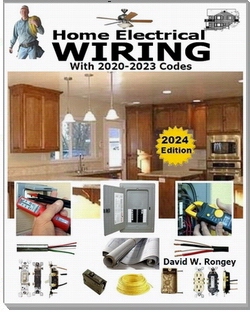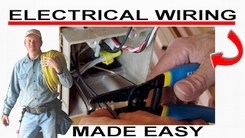More About Electrical SafetyRecent Questions and Comments
Problems with Dryer Outlet Wiring, Electric Dryer Circuit Wiring: I had a problem with my dryer outlet so I rewired it and now the dryer does not work, how can I fix my dryer? Electric Dryer Outlet Problems and How to Fix Them. GFCI Ground Fault Protection for Swimming Pool Lights: NEC Article 680-20, As described in this electrical question, anyone who enters the pool with this light on is in Danger of Potential Electrical Shock! Can I plug my EV Car Charger cord into an apartment garage using an extension cord? How you can get your electrical business back into operation and start getting new clients. |
» Home Electrical Safety
» Need Electrical Help? Ask the Electrician
Home Electrical Wiring Safety Checklist

|
Summary: This Home Electrical Wiring Safety Checklist will help you protect your home, your family, and your life. © By: Dave Rongey |
Identify Potential Home Electrical Wiring Hazards using this Checklist
Newer homes have been built according to the latest codes and with up to date features and equipment.
Unfortunately many beautiful but older homes have not been brought up to code and could contain outdated and possibly obsolete defective systems that could contribute to a disaster.
This checklist will assist you to examine some of the key areas and devices that may need to be updated in many older homes.
Checklist for a Safer Home Electrical System
Most Important
[ ] Older wiring could cause a problem if it is covered with insulation where it can overheat and create a real fire hazard. If you add insulation to your house, be sure not to cover wiring and fixtures unless an electrician has certified that they are rated for such conditions.
[ ] Smoke Detectors. Every home should have functioning smoke detectors in stairways, hallways and bedrooms. Each smoke detector should be tested monthly.
Outlets – Inspect these areas:
Living Rooms, Family Rooms, Bedrooms and other rooms as well.
What to look for:
[ ] Typical occupied rooms should have at least one outlet per wall spaced twelve feet apart or less. When outlets are not properly placed then extension cords will be used for items such as an entertainment system or a T.V. set.
[ ] Remove extension cords from dangerous locations.
The Problem with Extension Cords
Extension cords should never be used in place of fixed wiring. Damaged plugs or insulation can result in sparking. If extension cords are placed under rugs or through doors or windows they can be damaged or cut. This applies to all rooms in the home where most electrical devices are used.
Lighting – inspect these areas:
Kitchen, Bathroom
What to look for:
[ ] Each lighting fixture should have a sturdy protective electrical box. The wire and the insulation should not be damaged or starting to crumble.
[ ] Light bulbs should be sized correctly to the maximum watts as stated on the light fixture or the bulb socket. Using a larger bulb is not safe and could lead to over heating. If more lighting is needed then have look into replacing older fixtures with a new energy efficient fixture.
[ ] Closet lighting fixtures that use incandescent light bulbs too close to the shelf where sheets, blankets and towels, and other flammable materials which may come in contact with a hot bulb is an invitation for disaster. The solution: install a slim designed fluorescent fixture or move the fixture further away from the shelf.
[ ] Switches – inspect all areas, what to look for:
Sometimes switches can come loose from the wall, and the movement of the wiring back and forth can break connections that can damage the wire insulation, or make bare wires touch metal. These conditions can cause a fire. In a safely wired home, all the fixtures: lighting fixtures, switches, wall sockets, junction boxes, are insulated and firmly secured.
All Electrical Devices
[ ] Current wiring standards require a sturdy box at all junctions to contain any sparking.
Old wiring could have connections that are corroded, the insulation has cracked, and separated from the wires. Scorch marks are an indication of a dangerous overheating condition.
Home Electrical Professional Inspections
The Safest Way to Test Electrical Devices and Identify Electric Wires!The Non-Contact Electrical TesterThis is a testing tool that I have had in my personal electrical tool pouch for years, and is the first test tool I grab to help identify electrical wiring. It is a Non-contact tester that I use to easily Detect Voltage in Cables, Cords, Circuit Breakers, Lighting Fixtures, Switches, Outlets and Wires. Simply insert the end of the tester into an outlet, lamp socket, or hold the end of the tester against the wire you wish to test. Very handy and easy to use.
The Quickest Way to Check for Faulty Electrical Wiring!The Plug-In Outlet TesterThis is the first tool I grab to troubleshoot a problem with outlet circuit wiring. This popular tester is also used by most inspectors to test for power and check the polarity of circuit wiring. It detects probable improper wiring conditions in standard 110-125 VAC outlets Provides 6 probable wiring conditions that are quick and easy to read for ultimate efficiency Lights indicate if wiring is correct and indicator light chart is included Tests standard 3-wire outlets UL Listed Light indicates if wiring is incorrect Very handy and easy to use.
Strip Off Wire Insulation without Nicking and Damaging the Electric Wire!The Wire Stripper and Wire CutterMy absolute favorite wire stripping tool that I have had in my personal electrical tool pouch for years, and this is the tool I use to safely strip electrical wires. This handy tool has multiple uses: The wire gauges are shown on the side of the tool so you know which slot to use for stripping insulation. The end of the tool can be used to grip and bend wire which is handy for attaching wire onto the screw terminals of switches and outlets.. The wire stripper will work on both solid and stranded wire. This tool is Very Handy and Easy to Use. |
||
Residential Electrical Parts and AccessoriesLight Switches 120volt Outlets Circuit Breakers Electrician Tools Voltage Testers |















